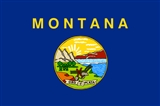
s" are found in the central third of the state, for a total of 77 named ranges of the Rocky Mountains
. This geographical fact is reflected in the state's name, derived from the Spanish word (mountain). Montana has several nicknames, none official, including: "Big Sky Country" and "The Treasure State", and slogans that include "Land of the Shining Mountains" and more recently, "The Last Best Place".
1864 Montana is organized as a United States territory.
1867 Atlantic Cable Quartz Lode gold mine located in Montana.
1870 In Montana, U.S. cavalrymen kill 173 Native Americans, mostly women and children, in the Marias Massacre.
1873 Indian Wars: whilst protecting a railroad survey party in Montana, the United States 7th Cavalry, under Lieutenant Colonel George Armstrong Custer clashes for the first time with the Sioux near the Tongue River; only one man on each side is killed.
1887 In a snowstorm at Fort Keogh, Montana, the world's largest snowflakes are reported, {{convert|15|in|cm}} wide and {{convert|8|in|cm}} thick.
1889 President Grover Cleveland signs a bill admitting North Dakota, South Dakota, Montana and Washington as U.S. states.
1889 Montana is admitted as the 41st U.S. state.
1910 An act of the U.S. Congress establishes Glacier National Park in Montana.
1917 Jeannette Rankin of Montana becomes the first female member of the United States House of Representatives.
1943 The Smith Mine #3 in Bearcreek, Montana, explodes, killing 74 men.

